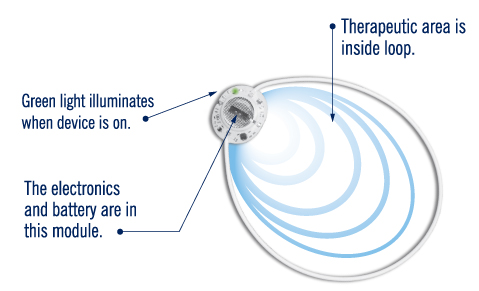RecoveryRx Medical Device (Non-thermal Pulsed Shortwave Therapy)
Indicated for the treatment of: Postoperative Pain
The Gap in Postoperative Pain Management
Pain is a normal, protective, physiologic process through which the brain communicates to an individual that tissues in the body (skin, nerves, muscles, joints, and internal organs) are in danger of being damaged or have been damaged. While pain is a complex sensory experience, it is normally composed of three major components:1) Nociceptive pain; 2) Inflammatory pain; and 3) Neuropathic pain. While nociceptive and inflammatory pain arise through activation of high-threshold sensory neurons, neuropathic pain arises as a result of direct damage to nerve fibers (stretching, contusion, inflammation, transection).
Surgical procedures involve a range of disruptions to bodily tissues, resulting in both nociceptive and inflammatory pain. As most tissues heal quickly, nociceptive and inflammatory pain typically resolve quickly. However, surgery also leads to nerve damage, resulting in neuropathic pain. Nerve tissue heals slowly, so neuropathic pain commonly takes 1-3 months to resolve. For 10%-40% of patients, neuropathic pain continues beyond this time, and can transition into chronic neuropathic pain, a condition referred to as surgery-induced neuropathic post-operative pain (SNPP). Several factors contribute to the emergence of SNPP, but the critical factor is the onset of CS.
Onset of Post-Surgical Central Sensitization (CS)
The two main nerve fiber types in the central nervous system (CNS) which normally transmit injury information to the brain, which in turn is communicated as pain, are the small diameter A-delta and C fibers. Following an incision, the signals carried by these fibers typically subside over a period of days. However, when the barrage of neural activity is severe, leading to extremely intense pain sensation, or is sustained for an extended period (hours, days, weeks), CNS function can be fundamentally altered through biochemical changes occurring in the dorsal horn of the spine. These alterations are known as central sensitization (CS).
The net effect of these alterations is that A-alpha and A-beta nerve fibers that normally do not communicate pain sensations but instead sensations such as touch and pressure, are now recruited into pain pathways. Stimuli which are normally not painful, (e.g., warmth or touch), are coded as painful (allodynia), and what would normally be mildly painful sensations (e.g., pressure) can lead to a feeling of intense pain (hyperalgesia). In effect, the individual’s pain threshold has been lowered by adding these new pathways. If nothing is done to reverse this threshold lowering, the individual’s pain level will not decrease over time and eventually become chronic pain.
Although all three types of post-operative pain can lead to CS, given the slow recovery time of damaged nerve tissue, the risk of developing central sensitization leading to chronic pain (SNPP) is much greater. This is because available pharmacotherapies (NSAIDs and Opioids) normally are effective at diminishing the nociceptive and inflammatory components of pain and thus the risk of developing CS because of these two pain types. However, these therapies do not directly address neuropathic pain, nor do they address the changes occurring in the CS and the development of SNPP. What is needed is a therapy that directly addresses the CS function and leads to a rise of the patient’s pain threshold.
RecoveryRx® Mechanism of Action
Few, if any, treatment strategies have been shown to be effective in reversing SNPP once it develops, and so the goal should be early intervention to reduce the risk of SNPP from developing. The key to reducing SNPP risk is to raise pain thresholds either pre-surgically or peri-surgically. This can be done by providing a barrage of non-painful stimuli to the CNS via the A-alpha and A-beta nerve fibers. This counterintuitive approach can be understood through the processes of habituation and sensitization which occur in the peripheral nervous system.

Figure 1:
1) Nerves severed during surgery produce chemicals and abnormal signals that increase pain signaling
2) Abnormal nerve activity alters excitability and responsiveness at the dorsal horn (central nervous system), amplifying pain and inducing central sensitization
3) Decreased modulation of inhibitory pain pathway further amplifies pain perception. Central sensitization can occur within hours of tissue injury.
Adapted from Kehlet H. et.al. The Lancet Vol. 367 Persistent postsurgical pain: risk factors and prevention, pages 1618-1625 (2006)
The peripheral nervous system continuously receives large amounts of sensory information from the environment. The background level of this activity is referred to as “afferent noise”. In order to send only relevant information to the brain, the peripheral system constantly adapts to the background noise level, so that only stimuli above the background noise level are sent to the CNS for processing. The raising of the background noise threshold is referred to as habituation while the lowering of the background noise level threshold is referred to as sensitization.
Slowing, or preventing, the development of CS requires a sustained presence of a non-painful, habituating stimulus to the CNS, essentially “instructing” the system to raise sensation thresholds – this is what the RecoveryRx does.
The RecoveryRx produces low intensity (non-thermal), radio-frequency, electromagnetic energy pulses which increases afferent nerve activity originating in the tissue region where nerve damage will, or has, occurred. These pulses are repeated at the relatively high rate of 1000 times a second. This rate is critical since the A-alpha and A-beta nerves specifically respond to higher frequencies of stimulation. Using the RecoveryRx over the surgical area, peri-surgically, increases A-alpha and A-beta activity. The CNS then “sees” the RecoveryRx produced nerve responses as increased afferent noise, resulting in a habituation-like response, leading to a rise in the pain threshold level soon after the surgery and in turn serves to reduce the risk of SNPP developing.
What is RecoveryRx®?
RecoveryRx is a class II, FDA-cleared, pulsed shortwave therapy (or non-thermal shortwave therapy) device which utilizes non-thermal, radio-frequency electromagnetic energy to treat postoperative pain and edema. When used adjunctively, RecoveryRx has been found to reduce postoperative pain and consumption of pain medication, including opioids.
The RecoveryRx is low powered, non-thermal, self-administered, easy to use and intended for continuous use up to 24 hours/day.

Summary of Clinical Evidence
The RecoveryRx was clinically evaluated in three randomized, double-blinded, placebo-controlled trials:
- A randomized, controlled, double-blinded study that investigated the effectiveness of RecoveryRx in treating postoperative pain in 18 women who underwent breast augmentation surgery. These women presented with the following average baseline demographics: 31.6 years of age, weight of 134 lbs and height of 5.52 ft. The primary outcome was a difference in daily pain, measured on a 0-10 visual analog pain scale. The results indicate that the effect of active treatment with RecoveryRx provides a statistically significant treatment effect (reduction in postoperative pain), when compared to placebo (p<0.05). Link to publication: (https://pubmed.ncbi.nlm.nih.gov/22037572/)
- A randomized, controlled, double-blinded study that investigated the effectiveness of RecoveryRx in treating postoperative pain in 72 women who underwent cesarean section surgery. These women presented with the following average baseline demographics: 26.1 years of age, gestation period > 37 weeks and singleton uncomplicated pregnancy. The primary outcome measure was differences in postoperative pain as assessed on a 0-10 visual analog scale. The results indicate that the effect of active treatment with RecoveryRx provides a statistically significant treatment effect (reduction in postoperative pain), when compared to placebo (p<0.05). Link to publication: (https://pubmed.ncbi.nlm.nih.gov/28060214/)
- A randomized, controlled, double-blinded study that investigated the effectiveness of RecoveryRx in treating postoperative pain in 150 woman who underwent cesarean section surgery. These women presented with the following average baseline demographics: 27.1 years of age, gestation period of 38.7 weeks and 2 prior cesarean section surgeries. The primary outcome measure was differences in postoperative pain as assessed on a 0-10 visual analog scale. The results indicate that the effect of active treatment with RecoveryRx provides a statistically significant treatment effect (reduction in postoperative pain), when compared to placebo (p<0.05). Manuscript under peer-review for publication.
Testimonials
“I use RecoveryRx™ on every facial procedure. It reduces my patients bruising and swelling by 50% following Blepharoplasty, Face Lifts, and Rhinoplasty. As a result of RecoveryRx, two weeks of standard surgical recovery has been reduced to 5-7 days.”
Laurie Casas MD, FACS
Northwestern University
Feinberg School of Medicine
Contact us today!
Have a question about the RecoveryRx® technology or products? Feel free to contact us at 1-866-757-2284 or recoveryrx@bielcorp.com. We are open Monday – Friday 9am-4pm EST.
Contact us!